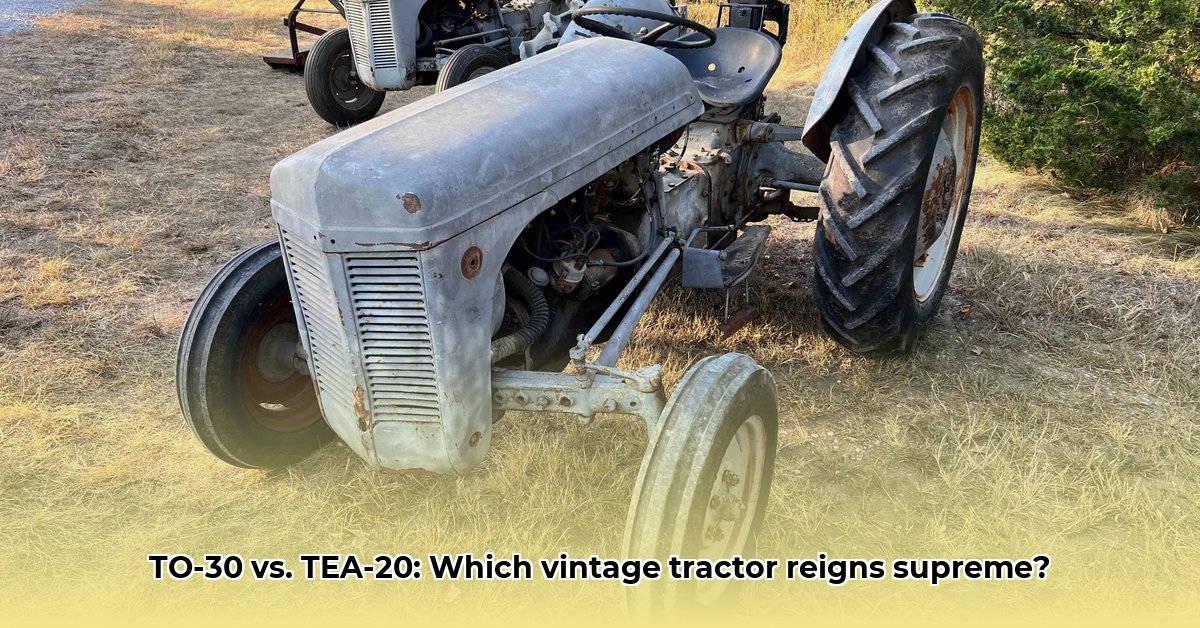
1952 Massey Ferguson Tractors: A Historical Overview
1952 marked a pivotal year for Massey Ferguson, with the introduction of two iconic tractors: the TO-30 and the TEA-20. These machines weren't merely agricultural implements; they represented a significant leap forward in farm technology and global market strategy. The TO-30, primarily aimed at the American market, exemplified power and efficiency, while the TEA-20, with its versatility and adaptability, conquered international markets. This article delves into the key differences and similarities between these agricultural legends, providing a comprehensive comparison for enthusiasts, potential owners, and anyone interested in the history of agricultural machinery. For more detailed information on the MF TO-30, check out this dedicated website.
Power and Performance: A Comparative Analysis
The most striking difference between the TO-30 and TEA-20 lies in their power output. The TO-30, designed for the expansive American farmlands, boasted a higher drawbar horsepower (the power used for pulling implements), making it ideal for larger-scale operations. This was crucial for the high-yield farming practices becoming prevalent in the United States. Conversely, the TEA-20, while possessing slightly less horsepower, offered unmatched fuel flexibility. Depending on regional availability, it could run on gasoline, kerosene, or diesel, a significant advantage in markets with limited fuel options. This adaptability proved key to its global success. Did this fuel flexibility outweigh the slight power deficit? The answer, as we'll see, depended heavily on the specific farming context and geographic location.
Manufacturing Locations and Market Strategies
Manufacturing locations played a crucial role in the tractors' design and market positioning. The TO-30, produced in Detroit, Michigan, targeted the American market, leveraging the advantages of a domestic manufacturing base. This choice likely optimized production costs and logistics within the expansive North American agricultural landscape. In contrast, the TEA-20 was manufactured in Coventry, England, underlining Massey Ferguson's strategic approach to international markets. The decision to build the TEA-20 in the UK allowed for easier penetration of European and global markets, capitalizing on existing distribution networks and lowering transportation costs to international customers. This geographic diversification effectively reflected Massey Ferguson's ambitious global expansion strategy.
Engine Specifications and Fuel Efficiency
Both tractors featured four-cylinder gasoline engines as their standard fuel source. However, the TEA-20's adaptability extended beyond gasoline; it could also operate on vaporizing oil and diesel fuel. This versatility was a major selling point, particularly in regions with unpredictable fuel supplies or varying fuel costs. The TO-30, while efficient with gasoline, lacked this crucial flexibility. This difference highlights the importance of understanding the local context – a key factor in determining which tractor would be best suited for a specific location and economic situation. Did the additional fuel options justify the TEA-20's slightly lower horsepower? This question is explored further in the technical specifications comparison below.
Transmission Systems and Operational Aspects
Both the TO-30 and TEA-20 employed four-speed unsynchronized gearboxes. This feature was typical for tractors of that era, but it presented a challenge to operators. Matching engine speed to gear changes required skill and precision to avoid gear grinding. While this was a common trait in vintage tractors, it represents a marked difference compared to the smoother, synchronized transmissions found in modern agricultural machinery. The less-refined transmission system could prove a challenge for inexperienced operators but was typical for the time.
Technical Specifications: A Detailed Comparison
The following table summarizes the key technical specifications of the TO-30 and TEA-20:
| Feature | TO-30 | TEA-20 |
|---|---|---|
| Engine Type | 4-cylinder Gasoline (Continental Z-120/Z-129) | 4-cylinder Gasoline (Standard), also capable of vaporizing oil and diesel |
| Drawbar HP | 24.37 hp | 23.9-28 hp (depending on pulley size) |
| Fuel Tank (gallons) | 10 | 8.2 |
| Transmission | 4-speed Unsynchronized | 4-speed Unsynchronized |
| Brakes | Differential Mechanical Shoe | Differential Mechanical Shoe |
| Production Location | Detroit, USA | Coventry, UK |
Beyond the Specifications: A Legacy of Innovation
The 1952 Massey Ferguson TO-30 and TEA-20 models were more than just tractors; they represented a pivotal moment in agricultural innovation. Their differences were not simply quirks of design but rather strategic choices reflecting varying market demands and global agricultural practices. They laid the groundwork for a new era of farming, highlighting the increasing importance of adaptability and international reach in the agricultural sector. Their contrasting strengths – the TO-30’s raw power and the TEA-20’s fuel flexibility – illustrate the dynamic forces shaping the evolution of agricultural machinery.
Choosing a Vintage Massey Ferguson: TO-30 or TEA-20?
Selecting between a vintage TO-30 and TEA-20 requires careful consideration of several factors. The TO-30, while powerful, suffered from known engine block cracking issues, impacting long-term reliability. The TEA-20, known for its adaptability and reliable Standard engine, offers potentially lower maintenance costs, but its lower horsepower might be a limiting factor depending on the scale of operations. Parts availability for both models varies, and restoration costs can be significant, influenced by local market conditions and access to specialized parts. The best choice will therefore depend on factors such as available budget, maintenance expertise, and the specific tasks the tractor is intended to perform. A thorough assessment of these factors is crucial before making a purchase decision.